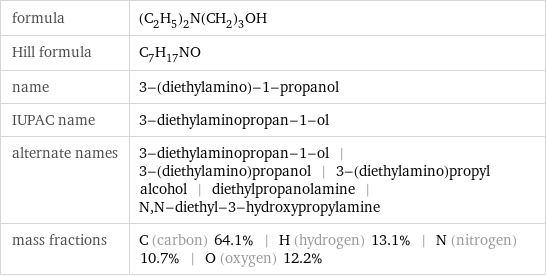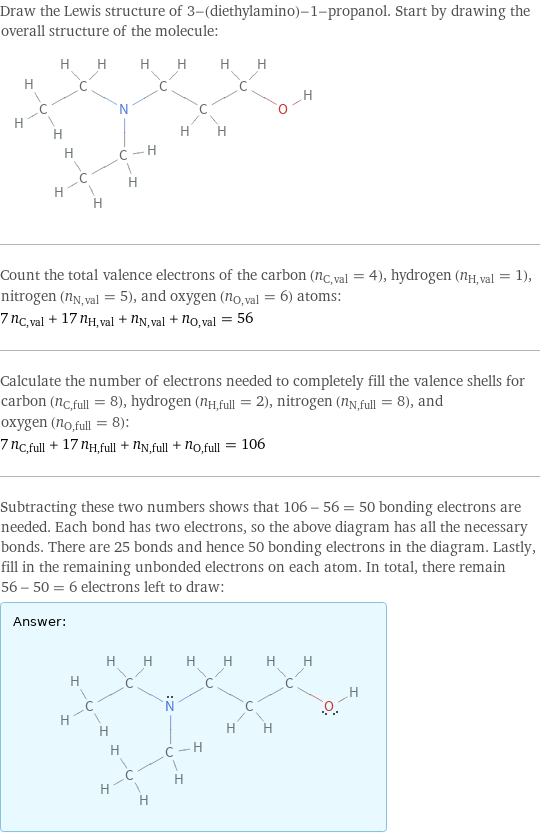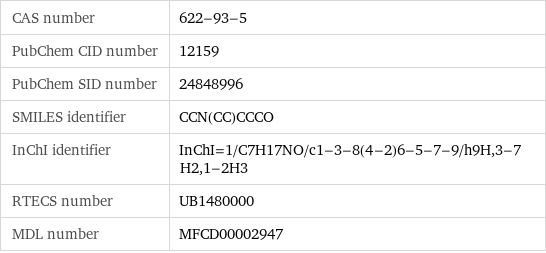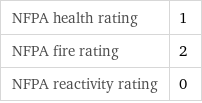Input interpretation

3-(diethylamino)-1-propanol
Chemical names and formulas

formula | (C_2H_5)_2N(CH_2)_3OH Hill formula | C_7H_17NO name | 3-(diethylamino)-1-propanol IUPAC name | 3-diethylaminopropan-1-ol alternate names | 3-diethylaminopropan-1-ol | 3-(diethylamino)propanol | 3-(diethylamino)propyl alcohol | diethylpropanolamine | N, N-diethyl-3-hydroxypropylamine mass fractions | C (carbon) 64.1% | H (hydrogen) 13.1% | N (nitrogen) 10.7% | O (oxygen) 12.2%
Lewis structure

Draw the Lewis structure of 3-(diethylamino)-1-propanol. Start by drawing the overall structure of the molecule: Count the total valence electrons of the carbon (n_C, val = 4), hydrogen (n_H, val = 1), nitrogen (n_N, val = 5), and oxygen (n_O, val = 6) atoms: 7 n_C, val + 17 n_H, val + n_N, val + n_O, val = 56 Calculate the number of electrons needed to completely fill the valence shells for carbon (n_C, full = 8), hydrogen (n_H, full = 2), nitrogen (n_N, full = 8), and oxygen (n_O, full = 8): 7 n_C, full + 17 n_H, full + n_N, full + n_O, full = 106 Subtracting these two numbers shows that 106 - 56 = 50 bonding electrons are needed. Each bond has two electrons, so the above diagram has all the necessary bonds. There are 25 bonds and hence 50 bonding electrons in the diagram. Lastly, fill in the remaining unbonded electrons on each atom. In total, there remain 56 - 50 = 6 electrons left to draw: Answer: | |
3D structure

3D structure
Basic properties

molar mass | 131.22 g/mol phase | liquid (at STP) boiling point | 82 °C (measured at 2000 Pa) density | 0.884 g/cm^3 solubility in water | very soluble
Units

Liquid properties (at STP)

density | 0.884 g/cm^3 refractive index | 1.444
Units

Chemical identifiers

CAS number | 622-93-5 PubChem CID number | 12159 PubChem SID number | 24848996 SMILES identifier | CCN(CC)CCCO InChI identifier | InChI=1/C7H17NO/c1-3-8(4-2)6-5-7-9/h9H, 3-7H2, 1-2H3 RTECS number | UB1480000 MDL number | MFCD00002947
NFPA label

NFPA label

NFPA health rating | 1 NFPA fire rating | 2 NFPA reactivity rating | 0
Safety properties

flash point | 65.56 °C
Toxicity properties

RTECS classes | drug